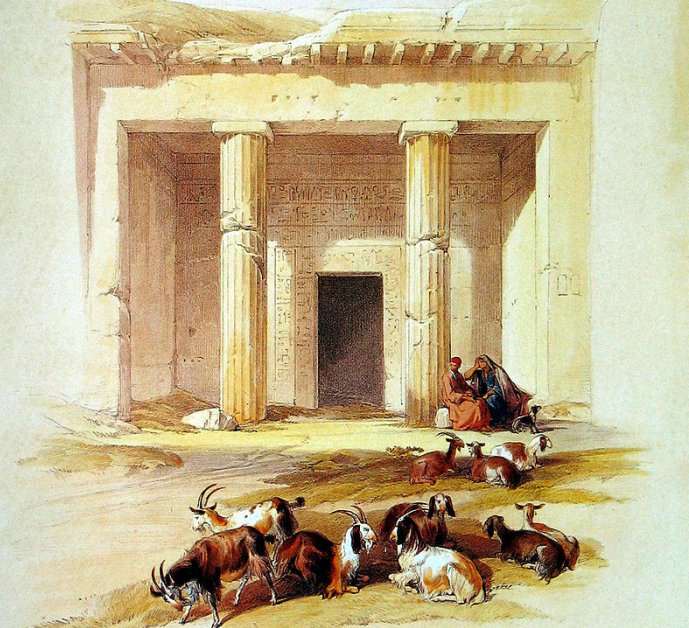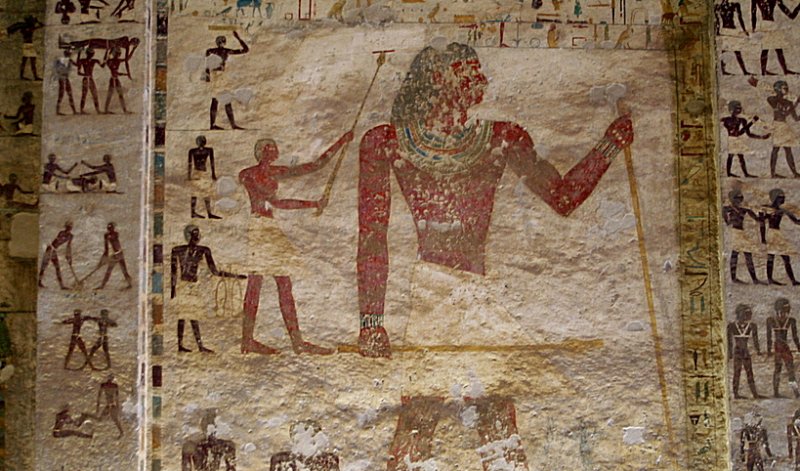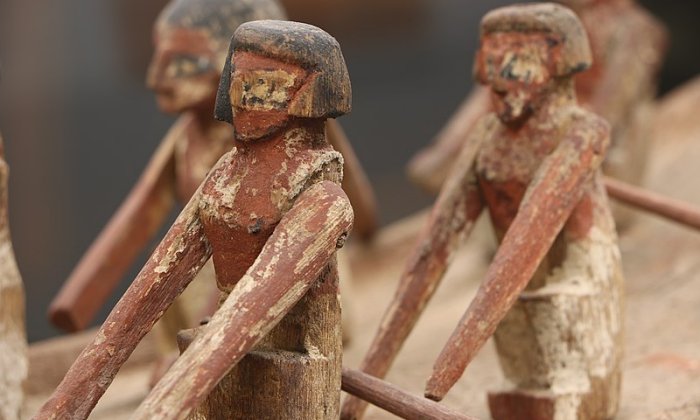Rock-Cut Tombs Of Beni Hasan With Spells, Prayers To Osiris And Anubis And Map To Underworld
A. Sutherland - AncientPages.com - The rock-cut tombs of an ancient Egyptian cemetery, Beni Hasan, were mainly used during the Middle Kingdom, from 21st to 17th century BC.
Entrance to a Tomb at Beni Hassan, David Roberts, 1838. Image credit: David Roberts - Public domain
They were constructed for many powerful nobles and provincial governors of the 11th and 12th dynasties (2125-1795 BC). During the reign of Sesostris III, many local workers decorated them, but later, when Sesostris III's power was reduced mainly, this burial tradition ceased.
There are 39 tombs carved into the limestone hillside south of the modern town of Minya on the east side of the Nile in Middle Egypt. Many have rich interior paintings depicting scenes from everyday life: most of them were robbed many times in antiquity.
However, the well-preserved wall decoration remained untouched until Percy Newberry, British Egyptologist, began meticulously recording every scene on the walls in 1890.
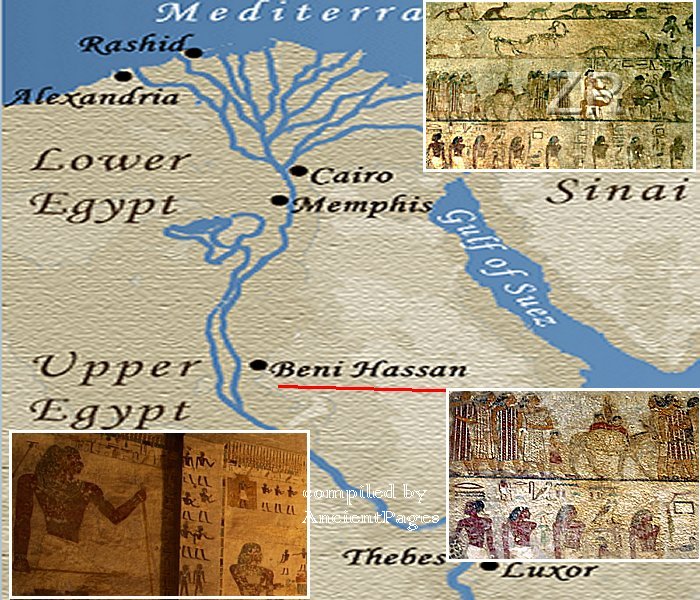 The tombs were constructed for many powerful nobles and provincial governors of the 11th and 12th dynasties (2125-1795 BC).
The tombs were constructed for many powerful nobles and provincial governors of the 11th and 12th dynasties (2125-1795 BC).
Ten years later, English archaeologist, John Garstang (1876 - 1956), came to Beni Hasan. During his two-year-long work, he unearthed and investigated almost nine hundred vertically-cut shaft tombs belonging to ordinary people who served the nobles.
Of all 39, only four of the tombs (those of Baqet III, Khety, Khnumhotep III, and Amenemhat) are available for visitors. The most impressive of them is that of Khnumhotep III, with a scene depicting the arrival of Asian visitors to Egypt.
Representation of Khety in his tomb (tomb 17). Image credit: Kurohito - CC BY-SA 3.0
The tombs have columned entrances and the walls painted in horizontal registers that run around them. There are scenes with the provision of food, gathering papyrus, fishing and hunting, spinning and weaving, but simple local workers and not artists made the decorations. The figures have long, stick-like limbs that are disproportionate in size, all painted in grey, pink and orange colors.
The ownership of the tombs was recorded on the painted wooden coffins, which contained several burials, perhaps the entire families). The coffins were inscribed with a prayer to Anubis or Osiris and decorated with a pair of eyes. Through the eyes, the deceased could see.
Spells painted on the coffins' inside guaranteed the deceased's passage to the afterlife, and a 'map' to the underworld on the coffin's floor guided the soul on its journey.
Beni Hasan model funerary boat with crew. Image credit: Voluremuseum - CC BY-SA 4.0
Many of the bodies were badly mummified and wrapped quickly in bandages. No investigation confirmed whether the bodies were buried at the same time or added in different periods.
The most curious feature of the tombs was the colorfully painted tiny, wooden models found in every chamber and depicting miniature figures working in granaries, bakeries, different shops, workshops of carpenters, goldsmiths, and other artisans and industries.
Archaeologists also discovered model boats with tiny figurines of wooden sailors and miniature human figures (no more than 15cm (6in) tall and about 7.5cm (3in) in the tombs of the governors. They symbolized 'continuously work' for the deceased in the afterlife.
The most beautiful is the grave of Khnumhotep III, an Ancient Egyptian high steward and vizier of the 12th Dynasty. The tomb's walls are covered with lively and colorful scenes with many themes and Khnumhotep's well-preserved biographical inscription.
Written by – A. Sutherland AncientPages.com Staff Writer
Updated on August 2, 2022
Copyright © AncientPages.com All rights reserved. This material may not be published, broadcast, rewritten or redistributed in whole or part without the express written permission of AncientPages.com
Expand for referencesReferences:
I. Rosellini, F.Serino, The Monuments of Egypt and Nubia
Hobson Ch. Exploring the World of the Pharaohs
Spara
Spara
Spara
Spara
Spara
More From Ancient Pages
-
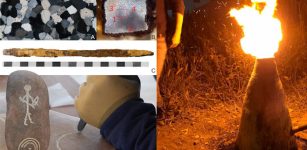 Steel Was Already Being Used In Europe 2,900 Years Ago – New Study
Archaeology | Mar 1, 2023
Steel Was Already Being Used In Europe 2,900 Years Ago – New Study
Archaeology | Mar 1, 2023 -
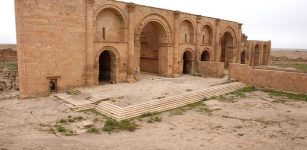 Hatra: Ancient Powerful Caravan City That Could Withstand Invading Roman Armies
Featured Stories | Dec 12, 2020
Hatra: Ancient Powerful Caravan City That Could Withstand Invading Roman Armies
Featured Stories | Dec 12, 2020 -
 Rare Hidden Copy Of Shakespeare Sonnet 116 Discovered In A 17th-Century Poetry Collection
Linguistic Discoveries | Mar 24, 2025
Rare Hidden Copy Of Shakespeare Sonnet 116 Discovered In A 17th-Century Poetry Collection
Linguistic Discoveries | Mar 24, 2025 -
 Selene – Greek Goddess Of The Moon And Myth About Love, Jealousy And Punishment
Featured Stories | Jan 24, 2019
Selene – Greek Goddess Of The Moon And Myth About Love, Jealousy And Punishment
Featured Stories | Jan 24, 2019 -
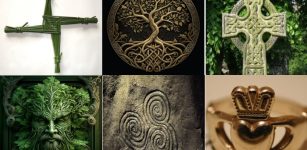 10 Ancient Celtic Symbols Explained
Ancient Symbols | Sep 9, 2023
10 Ancient Celtic Symbols Explained
Ancient Symbols | Sep 9, 2023 -
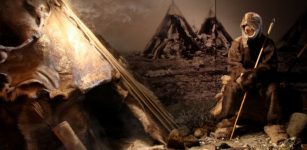 12,000-Year-Old Ice Age Stone Tools Found – Earliest Dated Evidence For Human Activity in Scotland
Archaeology | Oct 10, 2015
12,000-Year-Old Ice Age Stone Tools Found – Earliest Dated Evidence For Human Activity in Scotland
Archaeology | Oct 10, 2015 -
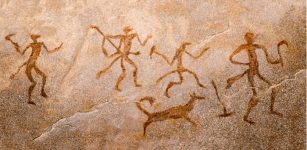 Hunter-Gatherer Genes Helped Early European Farmers Survive Disease – New Study
Archaeology | Mar 24, 2023
Hunter-Gatherer Genes Helped Early European Farmers Survive Disease – New Study
Archaeology | Mar 24, 2023 -
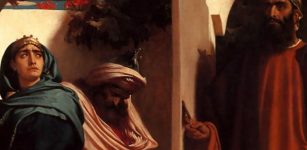 Jezebel Of Sidon – Wicked Wife Of King Ahab And Her Evil Rule
Biblical Mysteries | Aug 7, 2019
Jezebel Of Sidon – Wicked Wife Of King Ahab And Her Evil Rule
Biblical Mysteries | Aug 7, 2019 -
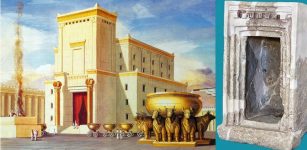 Mysterious Doorways In King Solomon’s Temple Leading To The Inner Shrine
Biblical Mysteries | Nov 30, 2017
Mysterious Doorways In King Solomon’s Temple Leading To The Inner Shrine
Biblical Mysteries | Nov 30, 2017 -
 Why Is The History Of Striped Clothing Dark And Sinister?
Featured Stories | Feb 12, 2025
Why Is The History Of Striped Clothing Dark And Sinister?
Featured Stories | Feb 12, 2025 -
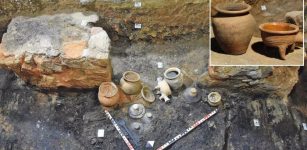 Uniquely Well-Preserved Medieval Kitchen Unearthed North of Moravia
Archaeology | Aug 11, 2022
Uniquely Well-Preserved Medieval Kitchen Unearthed North of Moravia
Archaeology | Aug 11, 2022 -
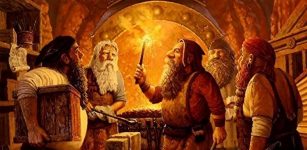 Brokkr And Eitri – Norse Dwarves Who Fashioned Magical Artifacts For The Gods
Featured Stories | Aug 19, 2019
Brokkr And Eitri – Norse Dwarves Who Fashioned Magical Artifacts For The Gods
Featured Stories | Aug 19, 2019 -
 Gryla: Cannibalistic, Evil Troll And Her Sons ‘Yule Lads’ – In Icelandic Folklore
Christmas Traditions | Dec 23, 2024
Gryla: Cannibalistic, Evil Troll And Her Sons ‘Yule Lads’ – In Icelandic Folklore
Christmas Traditions | Dec 23, 2024 -
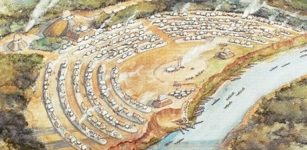 Is The Poverty Point Octagon World’s Largest Ancient Solstice Marker?
Featured Stories | May 21, 2017
Is The Poverty Point Octagon World’s Largest Ancient Solstice Marker?
Featured Stories | May 21, 2017 -
 Mysterious Underground City In Brazil Could Re-Write Ancient History – Riddle Of The 12 Men – Part 2
Ancient Mysteries | Jan 26, 2022
Mysterious Underground City In Brazil Could Re-Write Ancient History – Riddle Of The 12 Men – Part 2
Ancient Mysteries | Jan 26, 2022 -
 Cremation In The Near East Dates Back To 7,000 B.C.
Archaeology | Aug 13, 2020
Cremation In The Near East Dates Back To 7,000 B.C.
Archaeology | Aug 13, 2020 -
 Why Was Lovesickness A Feared Disease During The Middle Ages?
Ancient History Facts | Feb 8, 2018
Why Was Lovesickness A Feared Disease During The Middle Ages?
Ancient History Facts | Feb 8, 2018 -
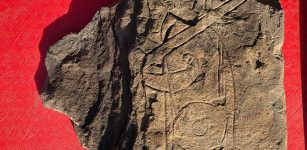 Remarkable Early Medieval ‘Govan Warrior’ Stone Discovered In Glasgow, Scotland
Archaeology | Sep 22, 2023
Remarkable Early Medieval ‘Govan Warrior’ Stone Discovered In Glasgow, Scotland
Archaeology | Sep 22, 2023 -
 The Day When The Sun Did Not Come Out – Bizarre Event In 1780, New England
Featured Stories | Apr 18, 2023
The Day When The Sun Did Not Come Out – Bizarre Event In 1780, New England
Featured Stories | Apr 18, 2023 -
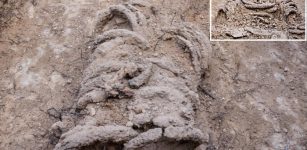 Skeletal Remains Of A 1,500-Year-Old Byzantine Ascetic Monk, Chained In Iron Rings – Uncovered Near Jerusalem
Archaeology | Jan 4, 2023
Skeletal Remains Of A 1,500-Year-Old Byzantine Ascetic Monk, Chained In Iron Rings – Uncovered Near Jerusalem
Archaeology | Jan 4, 2023

